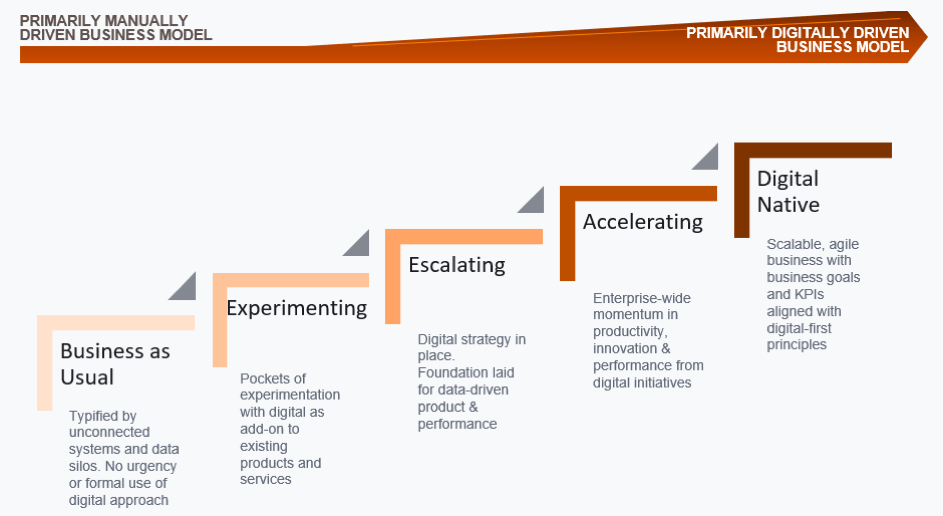
Every few years, a different technology or business solution takes off from its humble roots and goes on to radically change our world — think big data. These days it’s digital transformation that’s top of mind in every industry, including for financial service providers.
What exactly is digital transformation? Well, therein lies the rub. As much buzz as the term generates, there is often as much confusion about what exactly it means as what it entails. In truth, for all institutions, the definition lies somewhere on a spectrum. For some, digital transformation is a way to reduce costs by streamlining and automating operations, and for others, it represents the creation of digitally-enabled transformative business models that promise to deliver exponential growth and returns.
Organizations are struggling to find their way through the byzantine process of becoming more digitally mature. Even with a clear agenda, there are many challenges along the way: institutions must articulate real business value, set appropriate metrics, and ensure that their digital initiatives substantially benefit their employees as well as their customers.
At Accion, we recently embarked on an ambitious program with Mastercard to help millions of underserved microbusinesses successfully operate in — and benefit from — the digital economy. We are doing this by enabling financial service providers to run more efficiently, understand their customers better, and provide customized services that benefit those customers — including microbusinesses. This program is critical for socio-economic development because when small and micro businesses can participate in the digital economy through digital payments and other services, they can build records of transactions. These digital records, in turn, create opportunities for new financing models (e.g., digital lending, supply chain financing), improvements in business operations, and growth.
In order to benefit small businesses, the institutions that serve them have to get digital transformation right. We’ve worked with institutions across the globe all of whom operate in different contexts and at various levels of operational maturity. Time and again, we’ve found that a successful approach to digital transformation required:
- A common taxonomy: A standardized way of looking holistically at an organization from business model to culture to technology infrastructure and categorizing its position along a digital maturity spectrum.
- Understanding transitions: Analyzing how an organization travels along the spectrum, across all the various dimensions. What are the critical steps to move the dial and create impact? What do the enablers look like from one phase to the next?
- Adoption of fundamental principles: These principles are flexible enough to allow for differentiation and customization. They depend on the operating environment, desired outcomes and customer segments, among other factors.
These principles are the cornerstone of our digital transformation framework — a practical and comprehensive tool designed to help service providers navigate the complex digital landscape.
The framework outlines five critical stages of digital transformation, as well as the primary drivers and enablers that evolve to create a digitally-driven, scalable enterprise.

How to use the framework
Financial Service Providers can use the framework in various ways:
- As a diagnostic tool to determine the status of the organization along the digitization continuum. Accion’s quick assessment is a good place to start. By looking at the status of specific dimensions, you can identify the least digitally mature areas and assess where most progress has been made.
- You can use the framework to set your digital transformation vision and define specific maturity targets for each area. These targets will be relevant to your market, customers, budget, and organization capabilities.
- As a benchmarking tool for peer-to-peer comparisons and evaluations by financial institutions and other players, such as donors, development agencies, and investors.
- A handy reference for defining and prioritizing your organization’s many digital initiatives.
- As a communications tool from the board to customer service staff, the framework can be used to articulate the digital transformation vision, provide context, and measure progress.
At Accion, we’re using the digital transformation framework in all these ways and more to understand, map, and accelerate the transformation journeys of our partner FSPs and their customers.
Organizations face a daunting and disruptive digital journey. Accion’s digital transformation framework provides a much-needed compass for setting clear goals, designing and prioritizing strategic initiatives, and tracking progress throughout digital maturity stages. We hope institutions will use this resource to navigate digitization. By streamlining operations and developing customer-centric digital services, the financial services industry will be able to serve customers more efficiently and effectively, including the people who have been left out of the system for too long.









